The AMD Radeon R9 Fury X Review: Aiming For the Top
by Ryan Smith on July 2, 2015 11:15 AM ESTGrand Theft Auto V
The final game in our review of the R9 Fury X is our most recent addition, Grand Theft Auto V. The latest edition of Rockstar’s venerable series of open world action games, Grand Theft Auto V was originally released to the last-gen consoles back in 2013. However thanks to a rather significant facelift for the current-gen consoles and PCs, along with the ability to greatly turn up rendering distances and add other features like MSAA and more realistic shadows, the end result is a game that is still among the most stressful of our benchmarks when all of its features are turned up. Furthermore, in a move rather uncharacteristic of most open world action games, Grand Theft Auto also includes a very comprehensive benchmark mode, giving us a great chance to look into the performance of an open world action game.
On a quick note about settings, as Grand Theft Auto V doesn't have pre-defined settings tiers, I want to quickly note what settings we're using. For "Very High" quality we have all of the primary graphics settings turned up to their highest setting, with the exception of grass, which is at its own very high setting. Meanwhile 4x MSAA is enabled for direct views and reflections. This setting also involves turning on some of the advanced redering features - the game's long shadows, high resolution shadows, and high definition flight streaming - but it not increasing the view distance any further.
Otherwise for "High" quality we take the same basic settings but turn off all MSAA, which significantly reduces the GPU rendering and VRAM requirements.
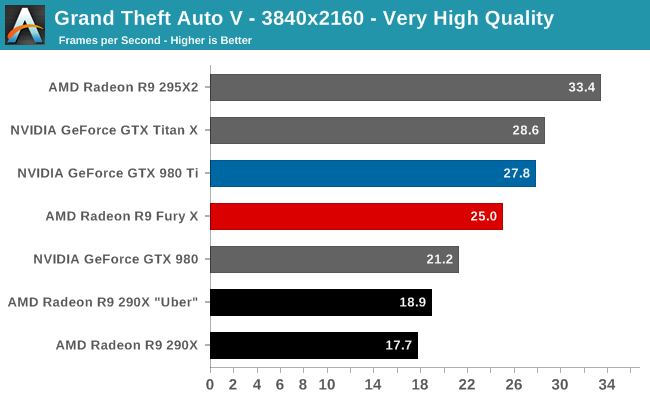
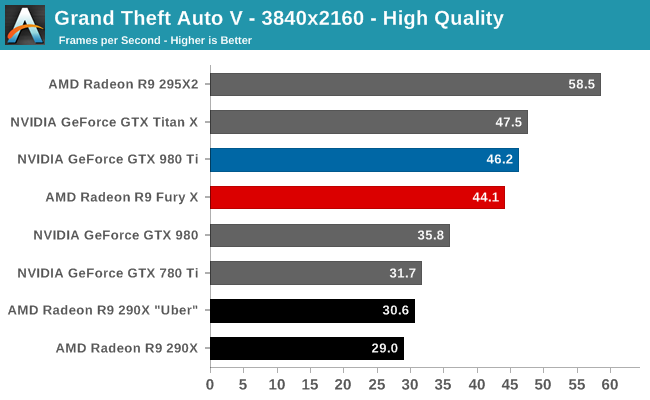
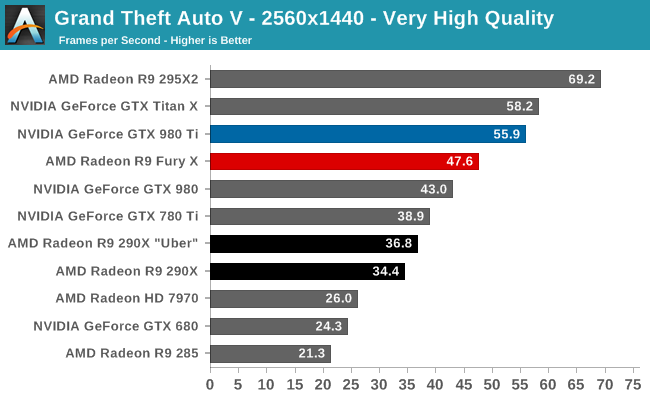
Our final game sees the R9 Fury X go out on either an average or slightly worse than average note, depending on the settings and resolution we are looking at. At our highest 4K settings the R9 Fury X trails the GTX 980 Ti once again, this time by 10%. Worse, at 1440p it’s now 15%. On the other hand if we run at our lower, more playable 4K settings, then the gap is only 5%, roughly in line with the overall average 4K performance gap between the GTX 980 Ti and R9 Fury X.
In this case it’s probably to AMD’s benefit that our highest 4K settings aren’t actually playable on a single GPU card, as the necessary drop in quality gets them closer to NVIDIA’s performance. On the other hand this does reiterate the fact that right now many games will force a tradeoff between resolution and quality if you wish to pursue 4K gaming.
Finally, the performance gains relative to the R9 290X are pretty good. 29% at 1440p, and 44% at the lower quality playable 4K resolution setting.
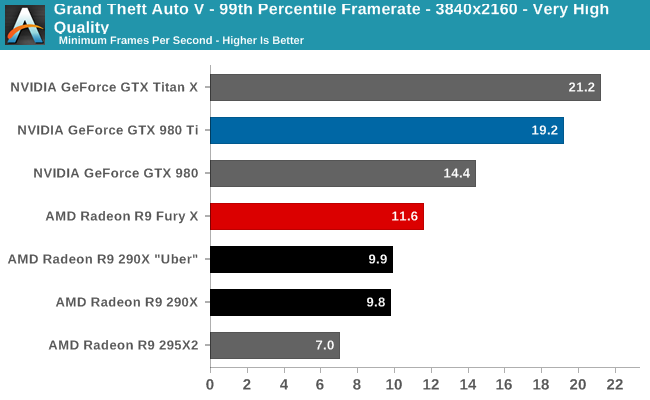
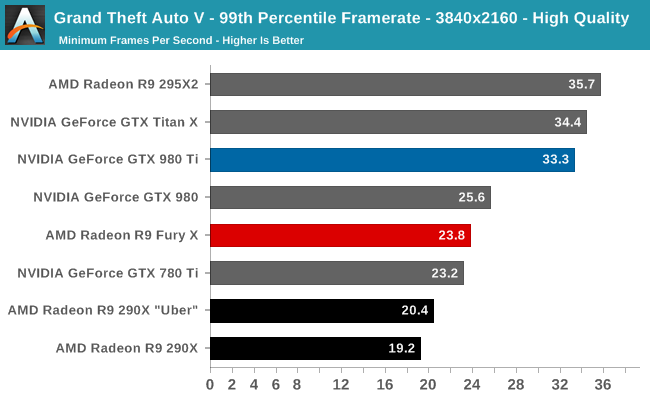
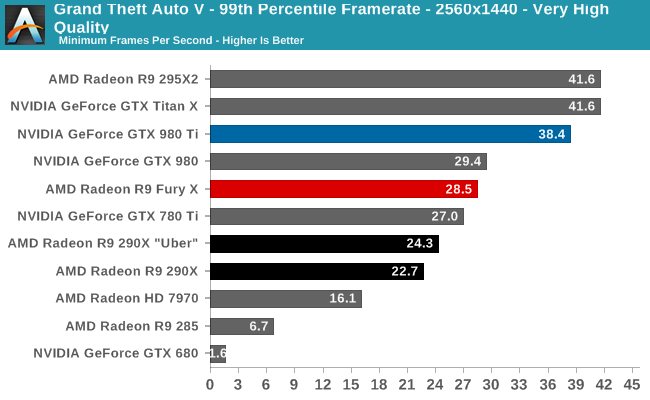
Shifting gears to 99th percentile frametimes however – a much-welcome feature of the game’s built-in benchmark – finds that AMD doesn’t fare nearly as well. At the 99th percentile the R9 Fury X trails the GTX 980 Ti at all times, and significantly so. The deficit is anywhere between 26% at 1440p to 40% at 4K Very High.
What’s happening here is a combination of multiple factors. First and foremost, next to Shadow of Mordor, GTAV is our other VRAM busting game. This, I believe, is why 99th percentile performance dives so hard at 4K Very High for the R9 Fury X, as it only has 4GB of VRAM compared to 6GB on the GTX 980 Ti. But considering where the GTX 980 places – above the R9 Fury X – I also believe there’s more than just VRAM bottlenecking occurring here. The GTX 980 sees at least marginally better framerates with the same size VRAM pool (and a lot less of almost everything else), which leads me to believe that AMD’s drivers may be holding them back here. Certainly the R9 290X comparison lends some possible credit to that, as the 99th percentile gains are under 20%. Regardless, one wouldn’t expect to be VRAM limited at 1440p or 4K without MSAA, especially as this test was not originally designed to bust 4GB cards.










458 Comments
View All Comments
looncraz - Friday, July 3, 2015 - link
We don't yet know how the Fury X will overclock with unlocked voltages.SLI is almost just as unreliable as CF, ever peruse the forums? That, and quite often you can get profiles from the wild wired web well before the companies release their support - especially on AMD's side.
chizow - Friday, July 3, 2015 - link
@looncrazWe do know Fury X is an exceptionally poor overclocker at stock and already uses more power than the competition. Who's fault is it that we don't have proper overclocking capabilities when AMD was the one who publicly claimed this card was an "Overclocker's Dream?" Maybe they meant you could Overclock it, in your Dreams?
SLI is not as unreliable as CF, Nvidia actually offers timely updates on Day 1 and works with the developers to implement SLI support. In cases where there isn't a Day 1 profile, SLI has always provided more granular control over SLI profile bits vs. AMD's black box approach of a loadable binary, or wholesale game profile copies (which can break other things, like AA compatibility bits).
silverblue - Friday, July 3, 2015 - link
No, he did actually mention the 980Ti's excellent overclocking ability. Conversely, at no point did he mention Fury X's overclocking ability, presumably because there isn't any.Refuge - Friday, July 3, 2015 - link
He does mention it, and does say that it isn't really possible until they get modified bios with unlocked voltages.e36Jeff - Thursday, July 2, 2015 - link
first off, its 81W, not 120W(467-386). Second, unless you are running furmark as your screen saver, its pretty irrelevant. It merely serves to demonstrate the maximum amount of power the GPU is allowed to use(and given that the 980 Ti's is 1W less than in gaming, it indicates it is being artfically limited because it knows its running furmark).The important power number is the in game power usage, where the gap is 20W.
Ryan Smith - Thursday, July 2, 2015 - link
There is no "artificial" limiting on the GTX 980 Ti in FurMark. The card has a 250W limit, and it tends to hit it in both games and FurMark. Unlike the R9 Fury X, NVIDIA did not build in a bunch of thermal/electrical headroom in to the reference design.kn00tcn - Thursday, July 2, 2015 - link
because furmark is normal usage right!? hbm magically lowers the gpu core's power right!? wtf is wrong with younandnandnand - Thursday, July 2, 2015 - link
AMD's Fury X has failed. 980 Ti is simply better.In 2016 NVIDIA will ship GPUs with HBM version 2.0, which will have greater bandwidth and capacity than these HBM cards. AMD will be truly dead.
looncraz - Friday, July 3, 2015 - link
You do realize HBM was designed by AMD with Hynix, right? That is why AMD got first dibs.Want to see that kind of innovation again in the future? You best hope AMD sticks around, because they're the only ones innovating at all.
nVidia is like Apple, they're good at making pretty looking products and throwing the best of what others created into making it work well, then they throw their software into the mix and call it a premium product.
Intel hasn't innovated on the CPU front since the advent of the Pentium 4. Core * CPUs are derived from the Penitum M, which was derived from the Pentium Pro.
Kutark - Friday, July 3, 2015 - link
Man you are pegging the hipster meter BIG TIME. Get serious. "Intel hasn't innovated on the CPU front since the advent of the Pentium 4..." That has to be THE dumbest shit i've read in a long time.Say what you will about nvidia, but maxwell is a pristinely engineered chip.
While i agree with you that AMD sticking around is good, you can't be pissed at nvidia if they become a monopoly because AMD just can't resist buying tickets on the fail train...